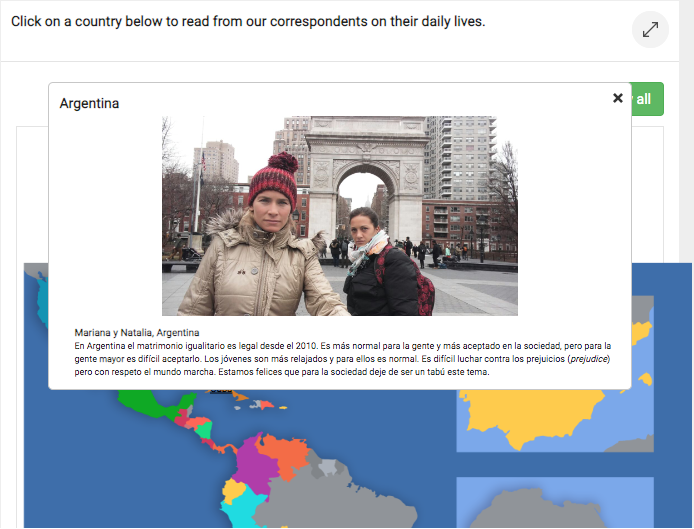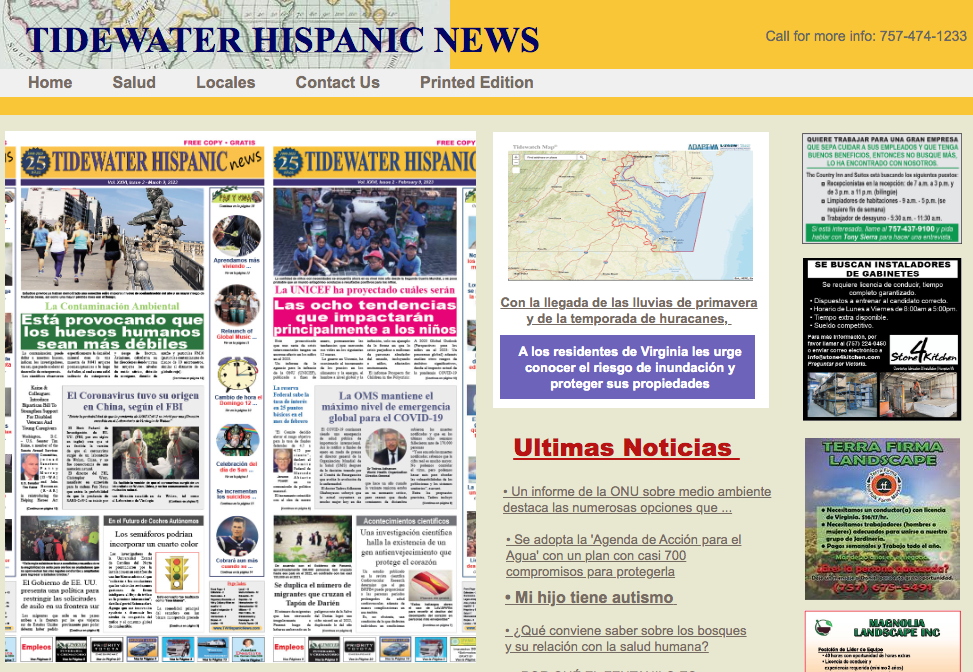Interpretive, Interpersonal, and Presentational Modes of Communication
Exploring Culture
One of the most valuable products or tools that I used this semester was actually our learning accompaniment LingroHub. Through this educational platform, I was exposed to a different aspect of cultural perspectives at the beginning of every module. For instance, one cultural exploration assignment may have covered expected gender roles for careers in various Hispanic nations, while another one explored the various national cuisines each nation is famous for producing. These glimpses into foreign cultures afforded me the opportunity to expand my understanding and shed any preconceived notions I may have had when comparing my culture to theirs.

After interacting with these windows into other cultures, I was surprised to find more commonalities than differences. This challenged my previously held worldview of wildly different attitudes, customs or norms being found as one crosses borders into other countries. In reality, we are much more alike as humans than I previously considered. One major difference is the types of foods that we eat, which may be more of a result of geography and weather patterns than proclivities or likes and dislikes. I was particularly pleased that, by exploring Colombian cuisine, I found a new refreshing drink to enjoy during the summer months. Below is a picture of that drink, the Limonada de Coco. I would likely have never heard of this drink if I had not interacted with the cultural exploration aspects of LingroHub.

Engaging in Communities
Engaging in community is ultimately important because community is the level of society which most directly impacts you after your immediate family. Community involvement strengthens the area in which you live by creating a sense of camaraderie and comfort in the place we collectively call home. By engaging with the community as a whole, previous obstacles to understanding such as difficulty in communication and differences in culture can be overcome to provide a greater sense of unity amongst the citizens. This deepened understanding is only magnified when that considered community is expanded to the global sphere. Engaging in communities is an effective way to illustrate our commonalities and reduce division.

Every now and then I would log on to the local Hispanic newspaper of Hampton Roads, Tidewater Hispanic News, to see what all I could gather or attempt to understand. This offered me insight into what was happening in the Hispanic community as well as on what social matters that community placed priority. It was interesting to find, once again, commonalities between cultures as far as what is considered ultimately important.
Interpersonal Communication
Over the course of this semester, it was incumbent on myself to schedule and complete two separate TalkAbroad conversations. These conversations were conducted with native-speakers of the Spanish language. One of my conversations was with a citizen of Colombia, and my second conversation was with a citizen of Mexico. In the first conversation, the subject matter involved descriptions of family members and family structure, while the second conversation revolved around hobbies and activities as well as taking care of oneself.
Engaging in the TalkAbroad conversations was and eye-opening experience, equally informative and enjoyable. They certainly helped to progress my comfort level with speaking the language. Before engaging in these conversational sessions, I was hesitant to put my language-learning lessons into practice. After the TalkAbroad sessions, I had a much greater sense of confidence in being able to conduct conversations surrounding the covered subject areas. This was enlightening because it showed me that, although it may be uncomfortable at first, the best way to achieve forward motion with language progression is to put the education into action.
I found that I excelled at listening intently and locking on to key words in order to determine context and continue the conversation. I was able to successfully address my conversational partners with follow up questions that were pertinent to the subject at hand. I learned that filler words and phrases can come in handy and be conversation-saving devices if used properly, so I would like to enhance my comfort with injecting them naturally into conversation in order to maintain flow. After my second TalkAbroad session, I found that I was even more comfortable than the first. This proves to me that both practice and putting practice into action are key elements to becoming a more comfortable Spanish language speaker.
Presentational Speaking
During this semester, we were responsible for submitting multiple videos wherein we are engaging in a pre-recorded conversation or predetermined set of responses. In this particular video which I have embedded below, I discuss my routines regarding my participation in sporting activities. I also discuss how these routines positively impact my lifestyle, as well as other ways to ensure self-care.
The first video presentation of the semester was the simplest to complete seeing as how it covered the absolute basics of conversational comfortability. From that starting point, I grew to be more concise with my sentences as well as particular about my word choices. I would explore vocabulary on my own time using a Spanish-English dictionary and my imagination, creating conversations in my head and considering how these conversations might play out. This afforded me the opportunity to both expand my vocabulary as well as become more comfortable with unexpected turns in conversation. Additionally, the level of ease with which I could present a given set of information became greater in turn.
Presentational Writing
Over the course of this semester, our class was exposed to a number of flyers, articles, and infographics covering a range of information. They covered the cultures of different countries, gender roles across various Hispanic cultures, different sports and recreational activities, and self-care techniques, just to name a few. Below is an infographic that I created with 5 quick tips of how you can take care of self.
¿Comó-te-cuidas-2Each new infographic or article or endeavor into new research afforded me the opportunity to expand my knowledge about the given subject matter. I was able to effectively convey possible techniques in which one could enhance their quality of life, which is an ultimately important facet of my own personality and personal routine. I was able to continuously refine the knowledge I gleaned as well as the information I was able to relay through written communication.
Interpretive Listening
Anytime we were tasked with listening to an audio file of spoken Spanish, we were tasked with determining the content using interpretive listening and auditory cues. Once I honed in on a few key elements of the audio file, I was able to interpret the rest of the words and sentences that I may not have initially recognized. Almost every module of LingroHub tasked us with an assignment of this nature.
Some of the material that I listened to being spoke of this semester included attributes of family members, structure of family, sports and affiliated terminology, careers and affiliated terminology, ways to take care of oneself and all about food and items associated with food. The most familiar to me was the food, being that Mexican food has been my favorite kind of food for quite a long time. Most challenging to me was likely the careers, but all-in-all, many of the terms used were cognates and otherwise similar.
Interpretive Reading
Again, in LingroHub, we would be commonly tasked to read entries and derive meaning from the text. I went about this in a very similar fashion to my interpretive listening, seeking first key words or words that I recognized in order to gain traction with my understanding. From there, I would look for the classic 5 questions. Who is speaking? What are they talking about? Where does this text take place? When is it taking place, presently, in the past or in the future? And finally, why does this text exist? Determining the answers to these basic questions enabled me to successfully engage in interpretive reading.